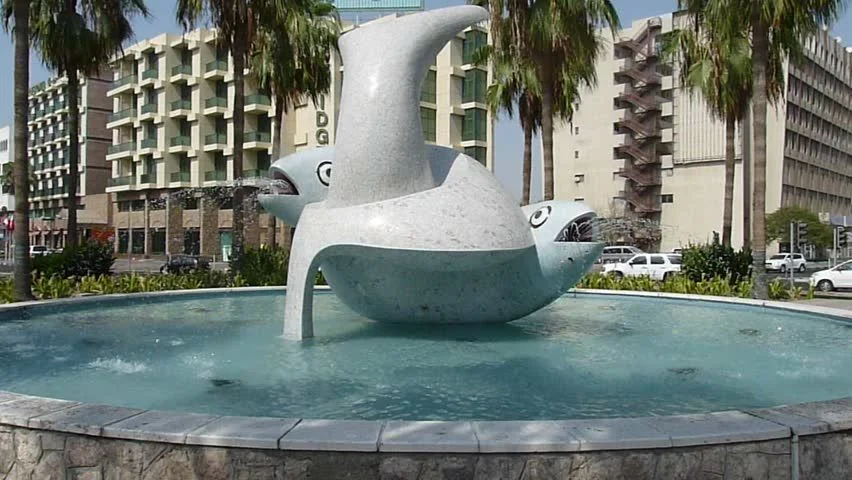Dubai, known for its iconic landmarks and architectural marvels, is home to the famous Fish Roundabout located in the vibrant district of Deira. This unique roundabout, adorned with a giant sculpture of a leaping fish, has become an emblem of the city, capturing the attention of residents and tourists alike. Let’s delve into the intriguing history and significance of the Fish Roundabout in Deira, Dubai.
A Symbol of Dubai’s Maritime Heritage The Fish Roundabout stands as a tribute to Dubai’s rich maritime heritage. As a city that evolved from a small fishing village to a bustling metropolis, Dubai owes much of its growth and prosperity to the sea. The fish sculpture at the roundabout serves as a visual reminder of the city’s deep-rooted connection to the Arabian Gulf and its reliance on fishing as an integral part of its culture and economy.
Striking Architecture and Design The architecture and design of the Fish Roundabout make it a standout feature in the Deira skyline. The centerpiece of the roundabout is a magnificent sculpture of a leaping fish, crafted with meticulous attention to detail. The fish sculpture, made of stainless steel, stands tall at approximately 7 meters in height, capturing the imagination of onlookers. The roundabout’s circular shape and well-planned road network make it a convenient and easily accessible landmark for commuters in Deira.
Landmark Location in Deira
Situated in the heart of Deira, one of Dubai’s oldest and most vibrant neighborhoods, the Fish Roundabout holds a strategic location. It serves as a major intersection connecting several key roads, including Al Khaleej Road, Abu Baker Al Siddique Road, and Omar bin Al Khattab Road. The roundabout’s prime position ensures that it remains a focal point of the bustling city, welcoming visitors and locals traveling to and from Deira.
Biya fish, also known as Asian sea bass or barramundi, is a species of fish that holds a special place in the culinary world. With its sleek silver body and distinctive pattern of scales, the Biya fish is not only a visual delight but also a treat for the taste buds. This versatile fish can be found in the coastal waters of Southeast Asia and is highly prized for its delicate flavor and firm, white flesh.
The Biya fish has gained popularity due to its ability to adapt to different cooking methods. Whether grilled, steamed, or pan-fried, this fish retains its natural flavor and remains moist and tender. Its mild, yet slightly sweet taste makes it a favorite among seafood enthusiasts, and it pairs well with a variety of seasonings and sauces.
Rich in nutrients, the Biya fish is a healthy choice for those seeking a balanced diet. It is an excellent source of high-quality protein, omega-3 fatty acids, and essential vitamins and minerals. These nutritional benefits contribute to overall well-being, promoting heart health, brain function, and reducing the risk of chronic diseases.
Hamour fish, also known as grouper, is a popular and delicious fish found in the Arabian Gulf region. This species is highly valued for its delicate flavor and firm, white flesh, making it a sought-after choice among seafood enthusiasts.
The hamour fish has a distinctive appearance, with a broad, flattened body and a large mouth, perfect for catching prey. Its coloration varies from dark brown to gray, blending seamlessly with its natural habitat of rocky reefs and coral formations. Renowned for its versatility, the hamour fish can be prepared in numerous ways, including grilling, baking, or frying, each method enhancing its unique taste.
The Hilsa fish, also known as Ilish or Pulasa, is a species of fish that holds a special place in the culinary and cultural traditions of South Asia. It is widely regarded as one of the most sought-after and prized fish varieties in the region. Hilsa fish is predominantly found in the rivers of Bangladesh, India, and Myanmar, with the Ganges and Brahmaputra rivers being its primary habitats.
What sets the Hilsa fish apart is its distinctive taste and flavor, making it a delicacy enjoyed by many seafood enthusiasts. Its flesh is tender, oily, and has a rich, distinct flavor that is truly unique. The fish is silver in color and has a slender, elongated body with sharp, pointed scales. It is highly valued for its soft texture and the way it melts in the mouth when cooked to perfection.
The Hilsa fish is not just known for its culinary excellence but also holds great cultural significance. In Bangladesh, it is considered the national fish and holds a prominent place in their cuisine and cultural celebrations. During the monsoon season, when the Hilsa fish migrates upstream to spawn, it becomes a major part of festivities and feasts.
Photographic and Touristic
Attraction The Fish Roundabout has gained popularity as a picturesque spot for photographers, both amateurs and professionals alike. The striking fish sculpture, set against the backdrop of Dubai’s skyline, presents a captivating image that has become synonymous with the city. Many tourists make it a point to visit the roundabout to capture memorable snapshots of their Dubai experience, further cementing its status as a touristic attraction.
Evolution and Future
Plans Over the years, Dubai has undergone rapid development and transformation. The Fish Roundabout, too, has witnessed changes and enhancements to accommodate the city’s growing needs. The area surrounding the roundabout has seen the construction of modern buildings, commercial centers, and hotels, contributing to the overall urban development of Deira. As Dubai continues to progress, the Fish Roundabout is likely to evolve alongside the city, adapting to future urban planning strategies.
The Fish Roundabout in Deira, Dubai, is a remarkable symbol of the city’s maritime heritage and progress. Its unique architecture, prime location, and captivating design make it a landmark that is both visually appealing and historically significant. As Dubai continues to thrive and evolve, the Fish Roundabout will undoubtedly remain an integral part of the city’s identity, attracting visitors and serving as a reminder of its rich cultural past. Read More Post Visit.






